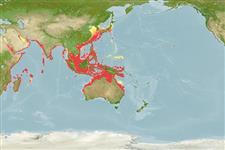Environment: milieu / climate zone / depth range / distribution range
Écologie
marin; océanodrome (Ref. 51243); profondeur 10 - ? m. Tropical; 47°N - 31°S, 34°E - 154°E (Ref. 54923)
Indo-West Pacific: Red Sea and East Africa to New Guinea, north to Japan, south to Australia. Reported in New Zealand (Ref. 89192).
Length at first maturity / Taille / Poids / Âge
Maturity: Lm 60.7 range ? - ? cm
Max length : 145 cm FL mâle / non sexé; (Ref. 40637); common length : 70.0 cm FL mâle / non sexé; (Ref. 168); poids max. publié: 35.9 kg (Ref. 168); âge max. reporté: 19 années (Ref. 97108)
Vertèbres: 39. A small species, deepest near the middle of the first dorsal fin base. The second dorsal fin is higher than the first dorsal fin; the pectoral fins are short to moderately long; swim bladder is absent or rudimentary. Lower sides and belly silvery white with colorless elongate oval spots arranged in horizontally oriented rows. The dorsal, pectoral and pelvic fins are blackish; the tip of the second dorsal and anal fins are washed with yellow; the anal fin is silvery; the dorsal and anal finlets are yellow with grayish margins; the caudal fin is blackish, with streaks of yellow green.
Predominantly neritic species avoiding very turbid waters and areas with reduced salinity such as estuaries. May form schools of varying size. Feeds on a variety of fishes, cephalopods, and crustaceans, particularly stomatopod larvae and prawns (Ref. 9684). Marketed mainly fresh and dried salted (Ref. 9684), but also smoked, canned and frozen (Ref. 9987).
Collette, B.B. and C.E. Nauen, 1983. FAO Species Catalogue. Vol. 2. Scombrids of the world. An annotated and illustrated catalogue of tunas, mackerels, bonitos and related species known to date. Rome: FAO. FAO Fish. Synop. 125(2):137 p. (Ref. 168)
Statut dans la liste rouge de l'IUCN (Ref. 130435)
Menace pour l'homme
Harmless
Utilisations par l'homme
Pêcheries: hautement commercial; pêche sportive: oui
Outils
Articles particuliers
Télécharger en XML
Sources Internet
Estimates based on models
Preferred temperature (Ref.
123201): 13 - 28.4, mean 26.5 °C (based on 1398 cells).
Phylogenetic diversity index (Ref.
82804): PD
50 = 0.5039 [Uniqueness, from 0.5 = low to 2.0 = high].
Bayesian length-weight: a=0.01413 (0.00814 - 0.02450), b=3.00 (2.85 - 3.15), in cm total length, based on LWR estimates for this species & Genus-body shape (Ref.
93245).
Niveau trophique (Ref.
69278): 4.5 ±0.6 se; based on diet studies.
Résilience (Ref.
120179): Faible, temps minimum de doublement de population : 4,5 à 14 années (K=0.32; assuming tm=2-4; tmax=18.7; Fec>1M).
Prior r = 0.32, 95% CL = 0.21 - 0.49, Based on 3 stock assessments.
Fishing Vulnerability (Ref.
59153): Moderate to high vulnerability (47 of 100).
Climate Vulnerability (Ref.
125649): High to very high vulnerability (75 of 100).
Nutrients (Ref.
124155): Calcium = 48.2 [25.8, 117.5] mg/100g; Iron = 3.01 [1.19, 7.29] mg/100g; Protein = 23.2 [21.8, 24.6] %; Omega3 = 0.316 [0.191, 0.535] g/100g; Selenium = 101 [27, 327] μg/100g; VitaminA = 44 [6, 332] μg/100g; Zinc = 0.489 [0.265, 0.931] mg/100g (wet weight);
